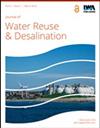农村废弃人工湿地的资源化利用:海水养殖废水处理
IF 2.3
Q2 Environmental Science
引用次数: 6
摘要
本研究旨在研究人工湿地(CW)在处理后的水从生活废水变为海水养殖废水时的行为变化。结果表明,海水养殖废水对氨氮、总氮和化学需氧量的平均去除率分别为29.54%、46.07%和57.15%,显著低于生活污水(分别为71.35%、66.34%和74.98%)。两种体系对硝酸盐和磷酸盐的去除率无显著差异(P>0.05)。通过对细菌群落和吸附特性的分析,结果进一步表明,两种体系对NH4-N的去除机理主要是底物吸附:海水养殖废水中NH4-N在底物上的最大吸附量为5432mg/kg,而生活污水中的最大吸附容量为18033mg/kg。在细菌群落方面,家庭水平上的优势细菌是生活废水中的维多利亚藻科(18.63%)和海水养殖废水中的卟啉单藻科(18.37%),表明细菌群落发生了显著变化。总之,本研究表明,常规CW可以用于处理陆基海洋养殖废水,但在应用过程中需要优化操作条件。本文章由计算机程序翻译,如有差异,请以英文原文为准。
Recycling of rural abandoned constructed wetlands: mariculture wastewater treatment
This study aimed to investigate the behavioral shifts of constructed wetland (CW) when the treated water was changed from domestic wastewater to mariculture wastewater. The results showed that the average removal efficiencies of ammonium nitrogen (NH4 -N), total nitrogen and chemical oxygen demand (COD) were 29.54, 46.07 and 57.15% in mariculture wastewater, respectively, which were significantly lower than those in domestic wastewater (71.35, 66.34 and 74.98%, respectively). While there was no significant difference in the removal efficiency of nitrate and phosphate (P> 0.05) between the two systems. Based on the analysis of bacterial community and adsorption properties, the results further indicated that the removal mechanism of NH4 -N between both systems was mainly due to substrate adsorption: the maximum adsorption capacity of NH4 -N on the substrate in mariculture wastewater was 5,432 mg kg , whereas that in domestic wastewater was 18,033 mg kg . In terms of bacterial communities, the dominant bacteria at the family level were Victivallaceae (18.63%) in domestic wastewater and Porphyromonadaceae (18.37%) in mariculture wastewater, which showed the significant alteration to the bacterial community. In conclusion, this study showed that conventional CW could be used for treating wastewater from land-based marine aquaculture, while the operating conditions needed to be optimized in the process of application.
求助全文
通过发布文献求助,成功后即可免费获取论文全文。
去求助
来源期刊

Journal of Water Reuse and Desalination
ENGINEERING, ENVIRONMENTAL-WATER RESOURCES
CiteScore
4.30
自引率
0.00%
发文量
23
审稿时长
16 weeks
期刊介绍:
Journal of Water Reuse and Desalination publishes refereed review articles, theoretical and experimental research papers, new findings and issues of unplanned and planned reuse. The journal welcomes contributions from developing and developed countries.
 求助内容:
求助内容: 应助结果提醒方式:
应助结果提醒方式:


